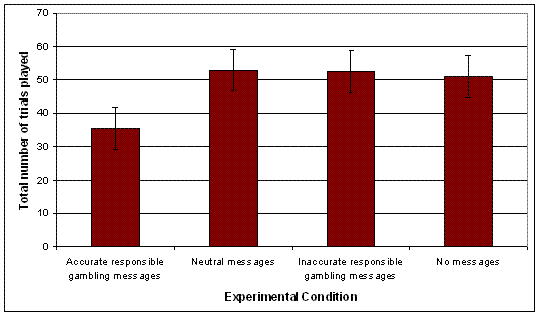The WAGER, Vol. 17(3) – You can’t control the Lucky Wheel: Using warning messages to reduce excessive gambling
Excessive gambling is linked to irrational feelings about the ability to influence chance-based games (as reviewed by Jardin & Wulfert, 2010). Correcting false beliefs about control over the outcome of games, then, might be an effective way to reduce excessive gambling. In this week’s WAGER, we review a recent study examining the effects of pop-up warning messages on gambling behavior (Jardin & Wulfert, 2010).
Methods
- Eighty adult gamblers (60 men; 20 women), recruited from the community, participated in the study. On average, they were 44 years old.
- Participants completed the South Oaks Gambling Screen (Lesieur & Blume, 1987), an assessment of gambling severity. Sixty-nine percent of participants qualified as possible or probable pathological gamblers; the remaining scored in the normal range.
- Participants completed a computerized gambling task called “Lucky Wheel.” They had a start-up fund of $1,000 in play money. They could wager varying amounts of that money on each spin of the wheel, and they could win or lose varying amounts of money on each spin. The reinforcement probabilities (i.e., the chance of winning) were pre-programmed and declined from the beginning of the task until the end. The researchers measured how many times participants spun the wheel (i.e., trials), how much money participants spent, and whether participants had any money left at the end of the game.
- The researchers randomly divided participants into four groups:
- The accurate message group saw pop-up warning messages designed to correct false beliefs about control over gambling (e.g., “Winning is completely due to chance.”)
- The neutral message group saw pop-ups with factual information (e.g., The Wheel of Fortune was invented in 1975.”)
- The inaccurate message group saw pop-ups that mimicked erroneous gambling beliefs (e.g., “The Lucky Wheel is a game of strategy.”)
- The no-message group saw no pop-up messages.
Results
- The researchers examined the effects of messages using MANOVA followed by focused tests. There was a significant effect of message condition on the combination of dependent measures, F (6, 150) = 3.54, p < .05, η2 = .13.
- Message condition influenced the number of trials played F (3, 76) = 8.90, p < .001, η2 = .26. Participants in the accurate message condition gambled fewer trials than everyone else. (See Figure 1.)
- Message condition also influenced the amount of money spent, F (3, 76) = 3.82, p < .05, η2 = .13. Participants who saw accurate messages bet less money than participants who saw inaccurate or neutral messages (but not less than participants who saw no messages).
- Participants in the accurate-message condition were more likely to have money left at the end of the game than people in all other conditions (all χ2 (1) > 7.00, all p < .05).
Figure 1. Total number of Lucky Wheel trials played as a function of condition. Error bars represent standard deviations. Adapted from Jarin & Wulfert (2012).
Limitations
- The researchers do not describe how they recruited participants. It is unclear whether their recruitment techniques inadvertently targeted individuals who are not representative of the larger population of excessive gamblers. For example, this sample might be especially interested in cutting down on their gambling.
- It is unclear whether this messaging system will be as effective in real-life casino environments, which are presumably more emotional and distracting and involve the potential loss of real money.
- The researchers did not measure gambling beliefs. Therefore, this study does not provide evidence that the warning messages reduced gambling by correcting false beliefs—just that warning messages reduced gambling.
Discussion
These results indicate that periodic reminders about the chance-based nature of gambling games reduce gambling behavior among a group of participants who tend to gamble excessively. Past work has demonstrated similar effects among recreational gamblers (Ladouceur & Sevigny, 2003). If future work signals that these effects are robust and applicable to the wider population of people who gamble excessively, responsible gambling advocates might wish to have these pop-up messages deployed widely as an additional harm minimization strategy.
-Heather Gray
What do you think? Please use the comment link below to provide feedback on this article.
References
Jardin, B. F., & Wulfert, E. (2010). The use of messages in altering risky gambling behavior in experienced gamblers. Psychology of Addictive Behaviors, 26(1), 166-170.
Ladouceur, R., & Sevigny, S. (2003). Interactive messages on video lottery terminals and persistence in gambling. Journal of the National Association for Gambling Studies, 15(45-50).
Lesieur, H. R., & Blume, S. B. (1987). The South Oaks Gambling Screen (SOGS): A new instrument for the identification of pathological gamblers. American Journal of Psychiatry, 144(9), 1184-1188.
